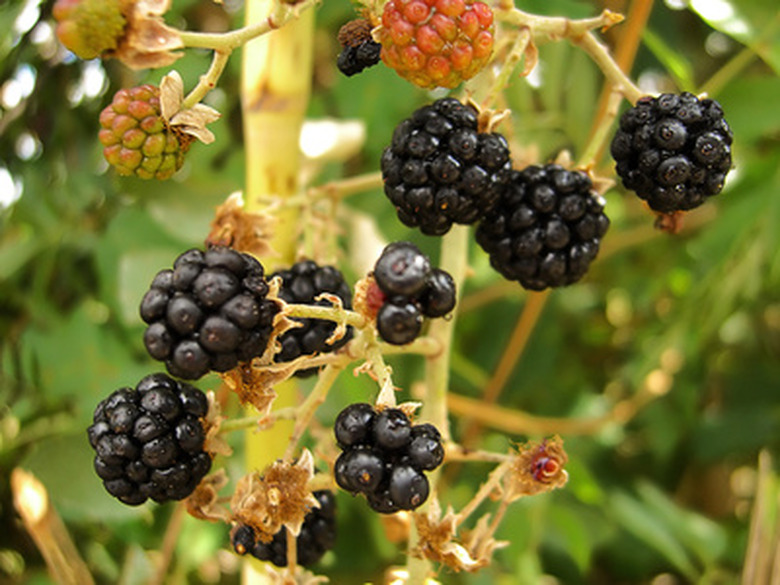Kinds Of Berry Trees
Although berry fruits more commonly grow on shrubs, a handful come from berry-fruiting trees. Many of the most common berry trees are surprisingly hardy and cold-tolerant. Some berry trees produce fruits that only birds and other wildlife eat, while others are edible for humans.
Hackberry Tree (Celtis occidentalis)
Winter birds often feed on the berries of the hackberry tree, which are small, dark-red to purple and less than a ½-inch in diameter. The hackberry tree is a hardy, tough tree that grows in a wide range of environments throughout North America. Reaching heights of 40 to 70 feet with a 50-foot spread, the hackberry tree has spearhead-shaped, 2- to 4-inch-long leaves that have small teeth along the edges and grow alternately arranged along the twigs.
Downy Serviceberry (Amelanchier arborea)
The downy serviceberry, also called the shadbush or Juneberry, is a small shrub-like tree that grows to only 25 feet tall and wide. Blooming in white spring flowers, the downy serviceberry tree produces ¼-inch-wide, purplish berry fruits that attract birds and mammals but aren't suitable for humans. Found growing throughout the eastern United States and parts of the central region, the downy serviceberry has oval to oblong leaves with finely double-toothed edges that are less than 5 inches long.
- Although berry fruits more commonly grow on shrubs, a handful come from berry-fruiting trees.
- Blooming in white spring flowers, the downy serviceberry tree produces ¼-inch-wide, purplish berry fruits that attract birds and mammals but aren't suitable for humans.
Western Soapberry (Sapindus drummondii)
The western soapberry produces ½-inch-diameter, yellowish-orange fruit that resembles cherries. During May and June, the western soapberry blooms in white or yellow flowers that attract butterflies. Growing 25 to 30 feet tall and 25 to 40 feet wide, this berry tree is native to the southern two-thirds of the United States. The berries create a soap-like lather when mixed with water and were once used as a soap substitute by Native Americans. The western soapberry can withstand droughts, high winds and compacted soils.
Strawberry Tree (Arbutus unedo)
Growing 15 to 30 feet tall and wide, the strawberry tree is a slow-growing berry tree that produces small red or orange fruit that is just a ½ to 1 inch wide. The strawberry tree grows best in climates with mild winters and hot summers, blooming in pink, urn-shaped flowers from October until December. The strawberry tree's fruits are edible and used to make wines, liqueurs and jams.
- The western soapberry produces ½-inch-diameter, yellowish-orange fruit that resembles cherries.
- The strawberry tree's fruits are edible and used to make wines, liqueurs and jams.
Red and White Mulberry Trees (Morus rubra and M. alba)
Mulberry trees typically grow to about 50 feet tall and produce clusters of seedy aggregate berries that are edible for humans, birds and other wildlife. The red mulberry has reddish to dark-purple fruits and has slightly heart-shaped leaves with fine double teeth on the edges. The white mulberry has very similar leaves, but it produces white to slightly reddish fruits. Native to China, the white mulberry was introduced in the United States as an ornamental landscape tree and now grows wild in the Pacific and East Coast states. The red mulberry, however, is native to the United States and grows in the central and eastern states, except for the northernmost regions.
Chokeberry (Prunus virginiana)
The chokeberry is a small shrub-like tree that grows to only 20 feet tall at most and produces clusters of tiny dark-red berries that are about 1/3-inch in diameter. The berries are round and shiny with pits, eaten by a wide range of wildlife. People eat the berries less frequently, but sometimes use them to make jellies. The chokeberry grows in the northern United States and southern Canada, in a wide range of soil types along the edges of forests, in open fields and near uncultivated farmlands. This berry tree blooms with elongated clusters of tiny white flowers and has small, oblong leaves with fine double teeth around the edges.
- Mulberry trees typically grow to about 50 feet tall and produce clusters of seedy aggregate berries that are edible for humans, birds and other wildlife.
- The chokeberry is a small shrub-like tree that grows to only 20 feet tall at most and produces clusters of tiny dark-red berries that are about 1/3-inch in diameter.
